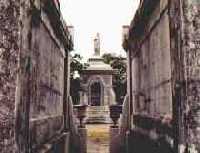
![]()
Prowling the Cities of the Dead
St. Roch No.1
Founded in 1874, Father Thevis vowed to build the cemetery chapel when church members were spared in the yellow fever epidemic of 1868. In the chapel is a wooden altar and shrine to St. Roch with the stations of the cross surrounding the cemetery in wall vaults. Most interesting is the Ex-Voto room to the right of the altar, which has objects that depict answered prayers. Replicas of hands, feet, and crutches and a statue of St. Lucy with eyeballs of a plate decorate the room. St. Roch No. 1 is located at Derbigny and St. Roch.
Holt Cemetery
Located near General Diaz and Weiblen Place (off of Canal), Holt was founded in 1879 to take over the Locust Grove Cemeteries used for the Negro population. The new location was built further away from the center of the city so that the indigent dead would not have to be carried through the streets. The price to be buried in Holt is the cost of digging the grave, and after that, the families and relatives must maintain the plot. Holt – with its old rusty fences, moss-draped oaks and unmarked graves – makes for an interesting "off the beaten path" excursion, and the back gate is always open to the public.
Lafayette No. 1
One of New Orleans, most well-known cemeteries, Lafayette No. 1 was built on the Livaudais plantation and was originally established as a cemetery for the city of Lafayette. Built in 1833, it was the city’s first planned cemetery and was placed on the National Register of Historic Places. Lafayette cemetery features in many of Ann Rice’s novels, and German and Irish yellow fever victims are buried here. It is located right across the street from Commander’s Palace at 1400 Washington Avenue.

![]()
Metairie Cemetery
Built in 1872, Metarie cemetery is on what had once been the Metairie Race Course. One local legend has it that Charles T. Howard, one of the cemetery’s founders, was not allowed to join the Metairie Jockey Club which owned the Race Track. When refused membership, he vowed that the racetrack would become a cemetery. His tomb is located on Central Avenue in the cemetery.
Metairie is the first cemetery to be patterned after the "park-like" cemeteries of the Eastern US. There are more than 150 acres of mystifying tombs, statues, and grass fields. Especially interesting is the Briede tomb, modeled with Egyptian influences and the towering Army of Northern Virginia, La. Division tomb. Other highlights include the stained glass windows of the Chapman Hyams tomb, designed after a Greek Peripteral temple, the Lefebre vault tomb, and the Menge tomb. It is perhaps one of the most peaceful and safest cemeteries in the city, and the wide roads make it easily accessible to vehicles. The Metairie Cemetery office (open 7am-5pm) offers self-guiding maps of the grounds.
Visiting the Cities of the Dead

![]()
Most of the city’s cemeteries can be reached via the city’s bus system RTA (Regional Transit Authority).
While Metairie cemetery is relatively safe and peaceful, many of the others, especially St. Louis No. 1, can be quite dangerous for solo travelers.
The Metairie Cemetery easily can be reached by public transportation and visited without a guide. The grounds are large and distances are far, but the cemetery is relatively safe by daylight. The office (open 7am-5pm) offers maps of the grounds.
St. Louis No. 1 Cemetery is best visited with a guide. It is easy to miss the highlights, and a local guide can show you things you would have missed otherwise. Furthermore, the cemetery lies on the outskirts of some of the city’s notorious housing projects, and going to the cemetery alone would be asking for trouble.
Historic New Orleans Walking Tours Inc. offers excellent tours leaving from the Café Beignet 334-B Royal St. (next to the polices station) everyday at 10am and 1pm (Sundays, 10am only). The "Cemetery/Voodoo History Tour" takes in Our Lady of Guadeloupe Church, the former site of Storyville, Congo Square, Louis Armstrong Park, and ends at an active Voodoo Temple.
Local guide "Mr. Jazz," Micheal Gourrier, says "it’s hard to compress 300 years of history in a two-hour tour," but he does a damn good job of giving visitors an overall history of the city and its people. Tours last two hours and are $15 per person, leaving rain or shine. The nonprofit Save Our Cemeteries organization offers professional guided tours to the Lafayette Cemetery and St. Louis No. 1. The tours to Lafayette No. 1 cost $6 for adults and are given every Monday, Wednesday, Friday, and Saturday, at 10:30am. The tours last about one hour, and begin and end at the cemetery gates, 1400 Washington Ave.